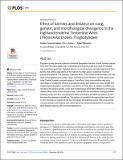Mostrar el registro sencillo del ítem
Effect of barriers and distance on song, genetic, and morphological divergence in the highland endemic Timberline Wren (Thryorchilus browni, Troglodytidae)
| dc.creator | Fuchs Castillo, Eric J. | |
| dc.creator | Camacho Alpízar, Andrés | |
| dc.creator | Barrantes Montero, Gilbert | |
| dc.date.accessioned | 2019-08-23T17:40:40Z | |
| dc.date.available | 2019-08-23T17:40:40Z | |
| dc.date.issued | 2018 | |
| dc.identifier.citation | https://doi.org/10.1371/journal.pone.0209508 | |
| dc.identifier.issn | 1932-6203 | |
| dc.identifier.uri | https://hdl.handle.net/10669/78910 | |
| dc.description.abstract | Populations may become isolated by distance, geographic barriers or both. Isolated populations often diverge in behavioral, morphological and genetic traits as a result of reduced inter-population gene flow. Highland species commonly present naturally fragmented distributions that confine populations to the highest mountain peaks, isolated by mountain passes and distance. The endemic Timberline Wren (Thryorchilus browni) inhabits the highlands of the Talamanca mountain range, including western Panama, and the highest peak in the Central Volcanic mountain range of Costa Rica. Using microsatellites and song recordings we studied the effect of a geographic barrier and distance on song, genetic and morphological divergence among four populations in Costa Rica. A lowland mountain pass resulted in the largest genetic, vocal, and morphological (bill length) differences among populations, likely due to reduce the gene flow. Cultural drift and assortative mating by females selecting songs from their own population likely accentuates the effect of isolation and limited gene flow between populations. This pattern of population divergence has been found in other Neotropical highland birds, but over larger geographical scales. We conclude that mountain passes and distance both reduce gene flow between populations in recently-isolated highland species with restricted distributions. | es_ES |
| dc.description.sponsorship | Universidad de Costa Rica/[]/UCR/Costa Rica | es_ES |
| dc.language.iso | en_US | es_ES |
| dc.rights | Attribution-NonCommercial-NoDerivatives 4.0 Internacional | * |
| dc.rights.uri | http://creativecommons.org/licenses/by-nc-nd/4.0/ | * |
| dc.source | PlosOne, 13(12): e0209508 | es_ES |
| dc.subject | Aves | es_ES |
| dc.subject | Fragmentación | es_ES |
| dc.subject | Microsatélites | es_ES |
| dc.subject | Cantos | es_ES |
| dc.title | Effect of barriers and distance on song, genetic, and morphological divergence in the highland endemic Timberline Wren (Thryorchilus browni, Troglodytidae) | es_ES |
| dc.type | artículo original | |
| dc.identifier.doi | 10.1371/journal.pone.0209508 | |
| dc.description.procedence | UCR::Vicerrectoría de Docencia::Ciencias Básicas::Facultad de Ciencias::Escuela de Biología | es_ES |
Ficheros en el ítem
Este ítem aparece en la(s) siguiente(s) colección(ones)
-
Biología [1644]



